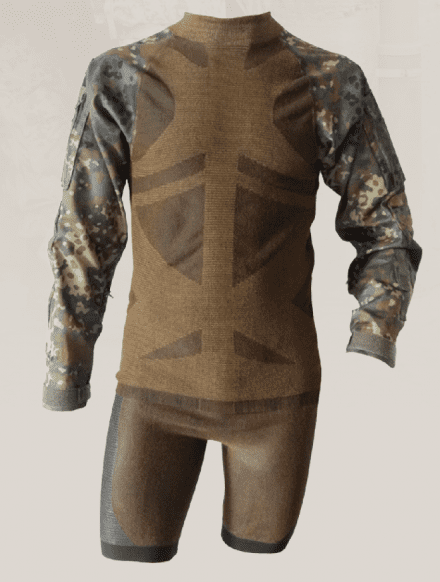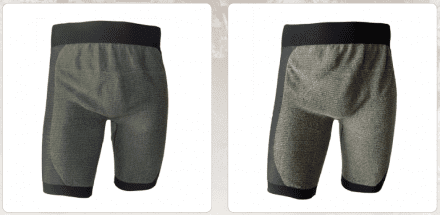One of the brands I encountered at Enforce Tac and IWA earlier this month was Hexonia. They have been working on Gladius, the German Army’s Future Soldier System and produce some very interesting knit garments.
They’ve done a lot of work on the clothing subsystem of Gladius which includes ballistic undergarments as well as Combat Shirt. Hexonia’s approach to ballistic underwear, called BALUW is the combination of three dimensional production techniques utilizing specialty yarns. As you can see, they offer body mapped knits for the torso of the garment. Their production offers ergonomically shaped products with significantly reduced number of seams, or in some cases, no seams at all. BALUW is worn as a first layer directly on the skin. The tight fit is to ensure that it can’t be blown away from the skin by a blast wave. Even the elastic zones are made of ballistic material and increase comfort without reducing the level of protection.
Their material combination also has excellent physiological properties. It has a very smooth hand against the skin and doesn’t lead to any abrasions. Additionally, thanks to the hydrophobic materials, sweat is absorbed readily and wicked away from the body. What’s more, the material is flame retardant with no burn, melt or drip. Finally, BALUW can be washed at 60 °C.
Tags: Hexonia




Where and how can I buy that?
Ditto. This reads like a Boy’s Life or Popular Science article on future clothing that I used to dream about! We officially live in the future.
“hydrophobic materials, sweat is absorbed readily and transported away from the body.”
How is a hydrophobic material going to absorb water and transport it. It’s hydro-PHOBIC, as in repels water, the antonym of absorb. A rain jacket is hydrophobic…so is the material going to repel the sweat from my groin area causing it to run down my leg….?
Or is it going to absorb it and transfer it away from the body to an area where, the sweat will be evaporated (causing something known as evaporative cooling).
I’m confused, it sounds like wearing a skin tight rain poncho on your balls that protects against flames and small particulate, high velocity, debris? Can you say muggy?
Hydrophilic. The word is Hydrophilic… While Polyester (assuming that’s what they use..) is technically hydrophobic, it’s often drawn into a different shape which makes it a hydrophillic yarn instead of a hydrophobic yarn.
http://www.tri-sis.ca/hydrophilic.html
If it’s hydrophilic it retains it. Hydrophobic material pushes it away.
“Additionally, thanks to the hydrophobic materials, sweat is absorbed readily and transported away from the body.”
That’s not how hydrophobic materials works. That’s how a hydrophilic material works, because it absorbs and spreads it out, possibly into a 2nd layer. If there is no absorption of sweat, then there can be no pushing sweat away from your skin AKA you need a hydrophilic material.
If you have a hydrophilic material it’s going to absorb and retain the moisture.
A hydrophobic material will never absorb any moisture from your skin. It will neither push any moisture through a garment. Dri-release (as in Nike Drifit etc.) is a mix of hydrophobic and hydrophilic staples (that are spun into a single yarn), because you need that absorption that a pure hydrophobic material does not offer.
Their statement is wrong. It’s the hydrophilic properties of their yarn that absorbs the moisture. If it’s a 2 layer construction (like Helly Hansen Lifa) where you have a 2nd layer that has a higher moisture regain than polyester, is the only time you’d actually have any transportation of liquids. Most of the time it’s just about spreading it out to a bigger surface allowing it to dry quicker.
If you still don’t believe me, talk to a material scientist. I know a few..
It’s not their statement, it’s my simplified translation of the German into English of what’s going on. The fabric isn’t absorbing moisture like cotton or or even untreated wool.
It passes it through and doesn’t retain it.